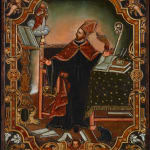Open a larger version of the following image in a popup:


St. Thomas Aquinas
Open a larger version of the following image in a popup:


St. Augustine of Hippo
SAINT AUGUSTINE OF HIPPO AND SAINT THOMAS AQUINAS
Unidentified artist, Lake Titicaca workshop, Bolivia, 1730
Oil and gold on copper.
30 x 22 cm.
Further images
Provenance
Private collection
St. Thomas Aquinas The central scene is framed by geometrical decorations accompanied by acanthus leaves and a couple of winged putti bearing long overlapping flower stems. Towards the bottom, a...
St. Thomas Aquinas
The central scene is framed by geometrical decorations accompanied by acanthus leaves and a couple of winged putti bearing long overlapping flower stems. Towards the bottom, a cartouche indicates the identity of St. Thomas Aquinas.
The model used for St. Thomas points to a certain dearth in reference sources or an interest in serial production, only that on this occasion the composition is reversed. The sole variations involve the iconography of the saint, who is pictured wearing the Dominican habit with biretta: a golden sun is hanging from a chain around his neck, symbolizing his wisdom; the apparition he is looking at is made up of the Holy Eucharist in a monstrance and, finally, one of his less frequent attributes, wings referring to the moment at which angels girded him with the cord of chastity. But in terms of the appearance of the furnishings and the posture of St. Thomas' body and his expression, the work follows the model set by the larger of the two St. Augustines.
This copper work is the pendant piece to the St. Augustine of Hippo belonging to the same series from this collection, and which we examined in the previous analysis.
St. Augustine of Hippo
The central scene is framed by geometrical decorations accompanied by acanthus leaves and a couple of winged putti bearing long overlapping flower stems. Towards the bottom, a cartouche indicates the identity of St. Augustine of Hippo.
This saint is portrayed as a young man depicted in profile and staring fixedly at the image of God as Savior, who is holding the cross in His left hand, while issuing a benediction with the right. The rest of the details, the attributes that enable us to identify the saint, along with his bishop's vestments, miter and crozier, books and flaming heart, are almost identical. As with the previous work, this painting also draws closely on the St. Augustine of Hippo by Philippe de Champaigne (Brussels, 1602 – Paris, 1674) from the LACMA in California. The tall lectern with its lion's paw feet; the book, some on the table and others on the floor, with one spread open on its pages with the saint's foot resting on it; the old man's posture, caught just as he turns towards the divine presence in his study. All of these elements are also present in Champaigne's canvas. Prints were an extremely important resource for artists in the Viceroyalty, and there is little doubt that this was the means by which the French artist's composition reached as far as the shores of Lake Titicaca.
This copper is a pendant work for a St. Thomas Aquinas belonging to the same series from this collection, and which we turn to now in our next analysis.



